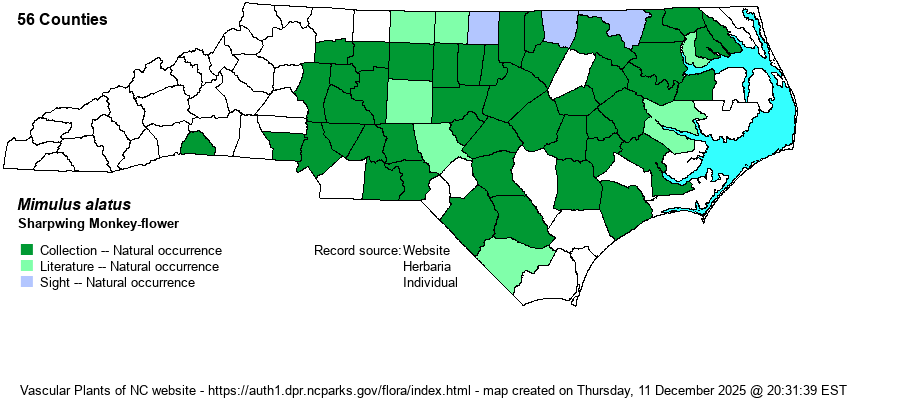| Author | Aiton | |
| Distribution | Present over most of the Coastal Plain and eastern and central Piedmont. Apparently absent in the Mountains and most of the western Piedmont, and seemingly absent in the far northeastern Coastal Plain, near the coast.
This is a Eastern species, ranging from CT to MI, and south to northern FL and TX. It is very scarce in the Appalachians; however, it is found in many TN counties next the NC state line, and thus could occur rarely in the lower and far western mountain counties.
| |
| Abundance | Fairly common to common in the central and western Coastal Plain; fairly common in the eastern and central Piedmont. Uncommon close to the coast, and very rare in the upper Piedmont. | |
| Habitat | This is a wetland species of ditches, marshes (more so along edges), openings in bottomlands, and other damp ground. |
| Phenology | Blooms from July into November, and fruits in the fall. | |
| Identification | This is an erect and moderately tall species, growing to about 2.5-3 feet tall. It has a square (4-sided) stem, with narrow but noticeable wings along the stems. The several sets of leaves are opposite and mostly lanceolate in shape, serrated, but with obvious petioles, about 1/2-inch or more long. Each leaf is about 4 inches long and about 1.5 inches wide. The large flowers grow from the upper axils of the leaves, but in this species the flowers are essentially sessile. In the very similar M. ringens, the flowers are on long pedicels to about 1-1.5 inches long, and that species has the leaves essentially sessile. Each has lavender-blue flowers that resemble a snapdragon, each being about 1-inch long or more (though the green sepals cover the corolla tube); the lower lip has some yellow in the throat. A stand of these species in bloom is quite showy and very hard to miss. Though their ranges overlap widely (essentially in the Piedmont), and the habitats seem to be identical, they seldom grow together in the same marsh or ditch. You should encounter each of these fairly often during the year; remember that M. alatus is the one with the sessile flowers but leaves that are not sessile; M. ringens -- the more dominant in the Piedmont (and the only one in the mountains) -- has the flowers on long stalks but the leaves are sessile. Also, M. ringens has essentially no wings along the 4-sided stem. | |
| Taxonomic Comments | None
| |
| Other Common Name(s) | Winged Monkey-flower | |
| State Rank | S4 [S5] | |
| Global Rank | G5 | |
| State Status | | |
| US Status | | |
| USACE-agcp | OBL link |
| USACE-emp | OBL link |

